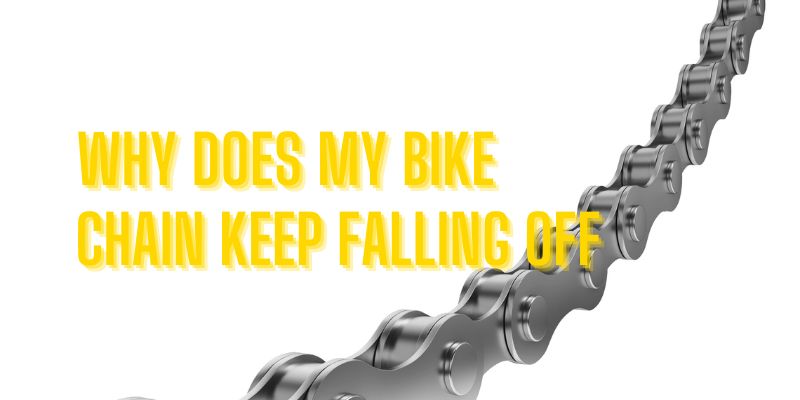Are you tired of asking yourself the same question again and again – “why does my chain keep falling off”? If that’s the case, you’d already know how annoying it is. Additionally, it can also be extremely dangerous.
In this article, I’ll explain why your bike chain keeps falling off and provide practical tips to fix this problem.
What’s Inside
Why Does My Bike Chain Keep Falling Off?
The first step to solving a problem is to identify it. So, let’s discuss the most common causes that lead to this problem.
Bike Frame and Parts
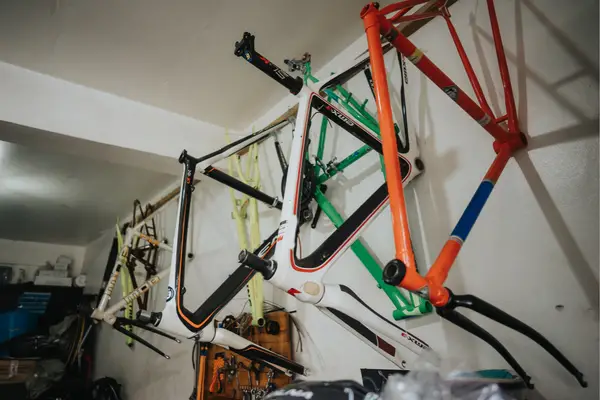
Your bike frame and parts can lead the chain to fall off if they’re loose.
Loose Bike Frame and Parts
One of the most common reasons why your bike chain just won’t stay put is a loose frame or other bike parts. If you think your bike has no loose parts, think again.
When you’re riding your bike, even the slightest looseness in the frame or other components can cause the chain to bounce.
Over time, this can lead to the chain slipping off the gears and derailleurs, and it leaves you pedaling in frustration with a limp chain dragging along behind you.
So, consider inspecting your bike thoroughly to check for any loose bolts or screws. A little tightening here and there could be all it takes to get your chain back on track!
Derailleur
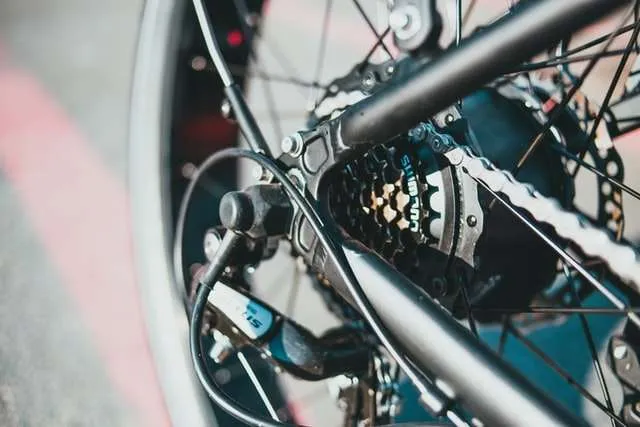
If your bike chain is slipping off constantly, it could be that your front or rear derailleur is to blame.
Front Derailleur
Let’s start with the front derailleur, which is responsible for shifting your chain between the two chainrings on your bike.
If it’s misaligned or out of position, it can cause the chain to slip off. And getting a chain wedged in between front chainrings can be extremely difficult.
Rear Derailleur
Your bike’s rear derailleur can also be the culprit, especially if you’ve been doing some serious off-roading lately. If its hanger is bent or damaged, it can cause uneven chain tension that leads the chain to slip off.
Chain
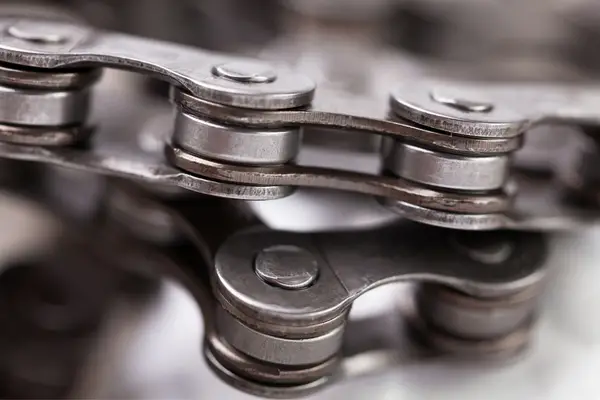
More often than not, the reason why your chain falls off repeatedly is some kind of issue with the chain itself, such as the following.
Chain Is Too Long
A chain that is too long can cause the bike to jump gears and fall off the chainring or cassette. It can also make shifting difficult and lead the chain to start dragging on the ground. In the worst cases, it can damage the chain or even other parts of the bike.
One of the main reasons a chain may become too long is due to wear and tear and stretching over time. However, improper installation or chain adjustment can also lead to this issue. So, it’s important to ensure the chain is installed properly and adjusted to the correct tension.
Worn Out Chain
If you can’t remember the last time you changed your bike’s chain, then it’s probably time for a new one. A worn-out chain can cause all sorts of problems, including the chain slipping off the cogs.
The easiest way to determine if your chain is worn-out is to use a chain checker tool. But if you don’t have this tool, you can take your bike to a professional mechanic to inspect the chain’s condition.
Additionally, make sure that you replace it with the new one if it’s worn out. You’ll notice a world of difference in your ride quality.
Clogged Chain
Dirt and grime can build up over time and cause the chain to slip and fall off. When the holes in the chain become clogged, they keep the chainring’s teeth from fitting in properly.
It leads to alignment issues and causes the chain to come off the cassette. You’ll face this problem more frequently if you like off-roading adventures.
Stiff Links
One thing you want to avoid in your chain is a stiff link. Not only can it cause the chain to skip and fall off the cogs, but it can also make it difficult to shift gears easily.
The easiest way to identify a stiff link problem is to put your bike up on a stand and shift through your gears slowly. Your aim is to determine if there are any tight spots on the chain.
If you find one, wiggle it around using a pair of pliers and add some oil to see if that helps. However, if the link is bent, you should consider replacing the chain. That’s because any adjustments will weaken the link, which can cause the chain to break in the future.
Cross Chaining
Have you ever found yourself in a situation where you shift gears, but your chain falls off? If that’s the case, it could be due to cross-chaining. This problem occurs when both your rear and front sprockets are set to the same extreme gear levels (smallest or largest gears).
It’s a common problem among beginners who unconsciously pedal hard and shift incorrectly. The best way to prevent this issue is to shift down on the small rear gears before moving to the front ones.
Cassette
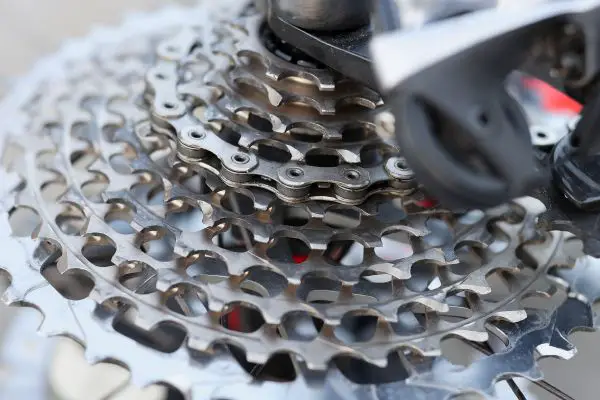
A cassette is a cluster of gears that sits on the rear wheel hub. It allows you to change gears and climb up hills conveniently. But like any other part of your bike, it can become damaged over time or due to a fall.
Worn Cassette Teeth
The teeth on the cassette can get damaged due to a stretched or worn-out chain. If these teeth start looking like shark teeth, it might be too late to save your cassette.
It means that they have become too worn and a new chain won’t be able to grip properly. As a result, you’ll experience the dreaded chain slipping or falling-off problem.
Common Fixes to Bike Chain Skipping
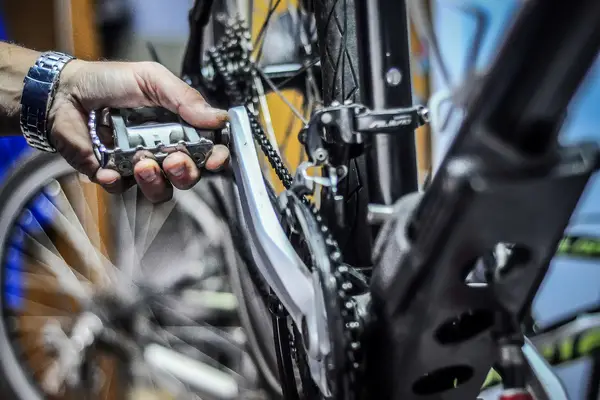
The following are some of the common fixes that you can use to prevent bike chain skipping.
Buy a New Chain
If you’re experiencing chain skipping, the easiest solution is to buy a new chain. While it may seem like an unnecessary expense, a new chain can work wonders for your bike’s performance.
It can eliminate skipping caused by a stretched or worn-out chain, as it’ll fit snugly with the cassette and chainring. In addition, it’s a relatively simple fix that you can perform yourself at home.
But before you go out and buy a new chain, make sure that you check the conditions of the existing one. If it’s in bad condition, opt for a new one compatible with your bike’s drivetrain.
You don’t want to end up with something that doesn’t fit or work well with your cassette or chainring.
Adjust the Chain’s Length
Adjusting the chain’s length is another common fix for a skipping chain. If it’s too long or too loose, it can skip over the teeth on the cassette. As discussed above, it happens due to wear and tear or improper chain installation.
To adjust the chain’s length, locate a small screw located on the rear derailleur. You can turn it clockwise to tighten the chain, or counterclockwise to loosen it.
It’s important to note that if your chain is too loose, you risk damaging your derailleur or even causing it to fall off completely. Whereas, if it’s too tight, it can cause unnecessary wear and tear, leading to a shorter lifespan for both the chain and cassette.
Remember to double-check your adjustments before taking your bike out for a ride to enjoy a smooth and safe cycling experience.
Replace the Bike’s Cogs
If you’ve replaced the chain and adjusted the length but the problem still persists, it’s time to look at your bike’s cogs.
You’ll need to replace them if they’re worn and look like shark teeth, or if the gaps between them are no longer uniform. Replacing this component on your bike might seem daunting, but it’s not as complicated as it sounds.
You’ll need a chain whip, a cassette lockring tool, and a bit of elbow grease. Start the process by removing the rear wheel and then remove the quick-release skewer. Next, attach the chain whip tool to any of the cogs, and place the lockring tool on the lockring.
After that, you’ll need to turn the lockring tool anticlockwise while holding the chain whip tool firmly. It’ll remove the lockring, allowing you to remove the old cassette. Now, all there’s left is to install the new cassette.
Remember, if you don’t feel confident, it’s always a better idea to take your bike to a professional to replace the cogs for you.
Inspect the Bike’s Frame
A damaged or misaligned frame can not only cause chain skipping, but it can also damage your bike beyond repair in the long run.
So, keep an eye out for any cracks or warping in your bike’s frame. Additionally, inspect the frame thoroughly after every ride for loose nuts and bolts.
If you suspect any problems, take your bike to a professional mechanic as soon as possible.
Clean Sprockets
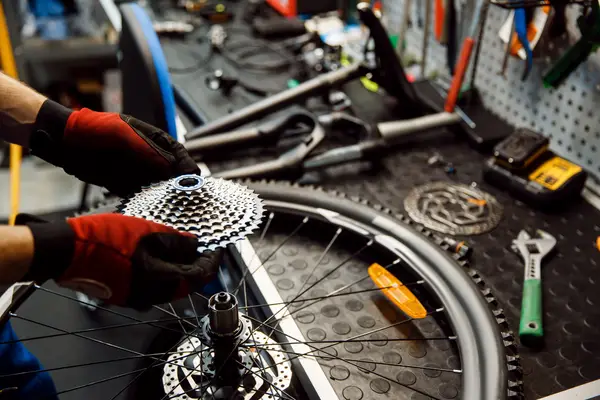
Other than causing the chain to skip, dirty sprockets can also lead to chain damage and sluggish shifting between gears. That’s why it’s important to keep them clean.
Use a stiff-bristled brush and a degreaser to remove any built-up dirt, grease, and grime from sprockets. If you don’t clean them when needed, the dirt and grime build-up will cause friction and lead to the skipping problem.
Make a habit of performing this drill once a month or right after every off-roading adventure to keep your sprockets clean.
Avoid Too Much Lube
While your bike’s parts, especially the chain, need lubrication, too much lube can be a bad thing. It’s not exactly a fix, but it’s a good preventative measure that can help you a great deal.
We all know that keeping the bike’s chain lubricated is essential for smooth and efficient riding. But applying too much lube can attract all sorts of dirt and grime, which can cause the chain to skip.
So, instead of drowning your chain in lube, use a moderate amount and wipe off any excess. If you’re not sure how much lube to use, just follow the instructions on the bottle.
Keep Your Bike Well-Maintained
Keeping your bike well-maintained is crucial, and it can also help you avoid chain skipping. First and foremost, make sure you keep your bike clean and lubricated all the time.
Regularly check your bike’s components, including the chain, cassette, and derailleur, and replace or repair anything that looks worn out or damaged. You want to catch any potential issues before they turn into something more serious.
It’s also important to store your bike properly to avoid any unnecessary wear and tear. Ideally, you should keep it in a safe and dry place, away from extreme temperatures.
Not only will it help you avoid the annoying chain-skipping problem, but it’ll also prolong your bike’s life.
Conclusion
A bike chain falling off isn’t an uncommon issue, and it can be extremely frustrating. But if you know the reason behind this problem, you can fix it easily.
Remember to inspect your bike thoroughly and look for the problems discussed in this guide to diagnose the problem quickly.
It’ll help you fix this problem effectively and enjoy a smooth and safe ride without worrying about your chain skipping or falling off. Happy riding!

